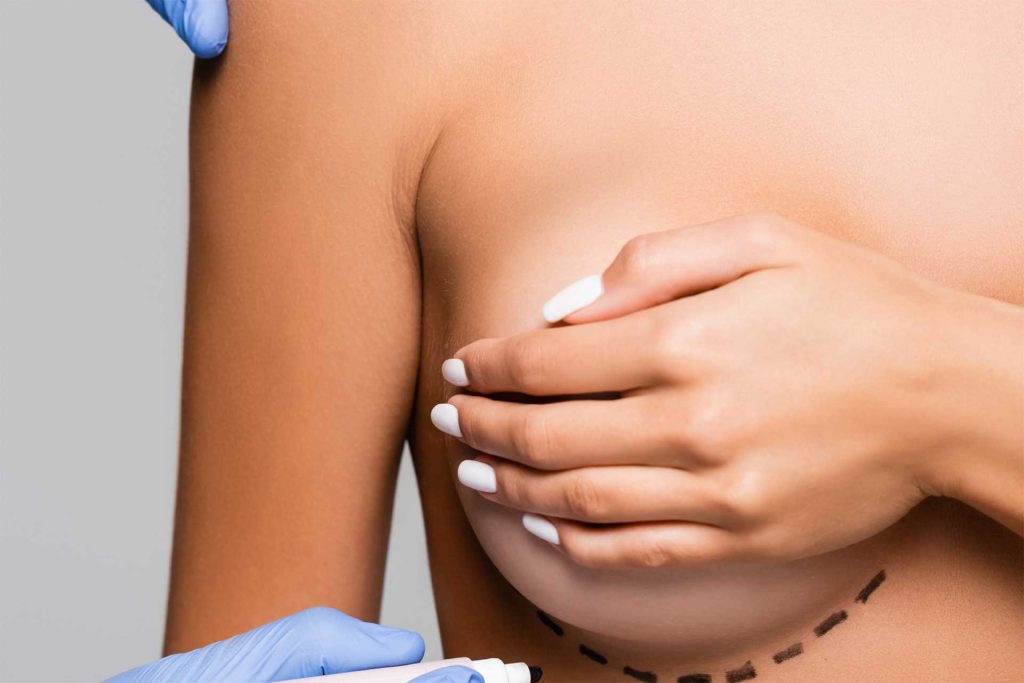AUGMENTATION MAMMOPLASTY/ BREAST AUGMENTATION/ BREAST IMPLANTS ETC
One of the most common procedures performed in cosmetic surgery is breast augmentation, also known as a “boob job” or “breast implants.” It was one of the very first types of plastic surgery that people underwent abroad, and today the custom of combining an international holiday with surgery is widely used and welcomed.
To achieve a larger bust, breast augmentation includes implants or fat transfer. Women who are dissatisfied with the proportion of their breasts to their hips after pregnancy or after losing weight frequently experience this.
A breast lift with augmentation may be required to provide elevated and larger breasts in order to treat excessively sagging breasts.
THE BENEFITS
Boost the size and projection of your breasts.
Rebalance the proportions of the breasts and hips
Improve your self-esteem and confidence

THE SURGERY
An incision is created at the start of the “Breast Implant” procedure (either in the crease of the breast, the armpit, or the perimeter of the areola, which is the dark skin surrounding the nipple). The placement of incisions vary depending on body shape and the finer details of each breast augmentation procedure.
The implant is then placed in a pocket which is either created behind the nipple immediately behind the breast tissue or behind the muscle of the chest wall.
The initial incision is stitched after it has been placed.
THE IDEAL CANDIDATE
Physically fit, mentally sound, and knowledgeable about the operation
Has been a constant weight for at least a year.
they’re dissatisfied with the size of their breasts
observing their breasts’ asymmetry
A more rounded breast shape is what you’re after.
As with any cosmetic surgery, it’s crucial to keep in mind that the procedure won’t make you into someone else, and you shouldn’t count on it to alter your life. When considering a treatment, it’s crucial to talk to someone you can trust, who is content with their life and understands that you’re not trying to change who you are at all; rather, you’re only looking to improve your appearance and confidence.
You must also be psychologically prepared.

PREPARING FOR
It is important to discuss and disclose:
If you have a pre-existing medical condition
Any medication you use, including prescription, over-the-counter, and herbal remedies
Upon arrival, you will meet with your surgeon for a physical examination to finalise the surgical plan and discuss your goals and concerns.
During this assessment, your doctor will choose the most appropriate course of action for you and go through all the specifics with you, including any potential drawbacks.
You should go into surgery with realistic expectations.
Your surgeon can also advise additional operations during this examination.
Prior to your surgery, it’s crucial that you give up smoking weeks prior to reduce risks and improve blood circulation.
RECOVERY AND POST-OPERATIVE CARE:
SURGERY DURATION:
Breast augmentation takes one to one and a half hours, depending on how extensive the treatment is. You will stay at the Hospital and be monitored – typically 1-2 nights and then be transported to your hotel for recovery.
POST SURGERY
Before wrapping the breasts in supportive gauze bandages, the incisions will be sealed with tape and closed. You will be required to wear the surgical bra that is fitted to all breast augmentation patients for several weeks as additional support. Medication can be used to treat typical post-operative problems like fatigue, soreness, and discomfort.
You’ll probably be told not to exercise or lift anything heavy for the first six weeks. You ought to be able to resume your regular activities following this.
It is crucial to be prepared that it can take a few months for your breasts to adjust to their new position.
It can take several weeks before the full effects of your augmentation become apparent.
Nipple sensation may be momentarily diminished, but it typically returns to normal as your breasts heal.
You will be given oral painkillers to relieve discomfort, and antibiotics will be recommended to stop any infections.
DURATION OF STAY:
The majority of surgeons advise taking a Medical Holiday of 7 to 10 days, during which time you will schedule routine follow-up meetings with your surgeon. We advise that you engage in light exercise and indulge yourself to make the most of your healing time. There is a lot to see and do in Turkey if you feel up to it!
COMPLICATIONS AND RISKS
All surgical operations can experience complications and risks.
There is a possibility of capsular contracture, which necessitates the surgeon to “score” the scar tissue, remove the implant(s), and replace them with new ones.
Excessive bleeding and infection in the vicinity of the implants.
For several months, scars could be visible, but they eventually disappear. Occasionally, for a while after surgery, nipples become excessively sensitive or insensitive.
Observing the surgical preparation and postoperative care guidelines provided by your plastic surgeon will increase success and reduce the risks of possible complications.
PREOPERATIVE SCREENING
Prior to hospital admission and surgery, it is standard hospital practice for your surgeon to do diagnostic tests and/or laboratory investigations to make sure you are healthy enough for surgery.
Before departing for a foreign country, the patient must undergo blood tests to avoid potential cancellations.
SIDE EFFECTS:
A momentary ache
Swelling\sSoreness
Modification of nipple sensation
RECOVERY
Return to work: Three to five days.
A more demanding physical activity three to four weeks is adequate
Healing : between a few months and a year (or longer, pending individual healing)
##Please take note## – This data serves as a guide for your potential care. During your initial visit, you must discuss and share with your surgeon your individual concerns and medical history.







